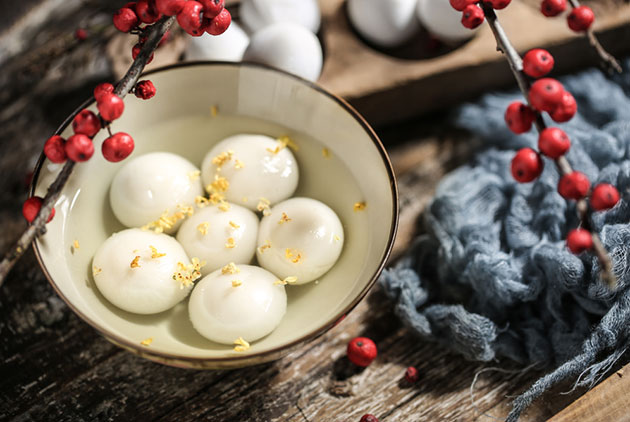Let's Eat the Taiwan Way
The Glue of Taiwanese Life—Sticky Rice

Source:CW
From sweet rice ball soup, zongzi, to sticky oil rice for celebrating a baby's first month, glutinous rice is milled into the most familiar and nostalgic flavors for Taiwanese. It is frequently a component of festivals throughout the year and at various stages of people’s lives.
Views
The Glue of Taiwanese Life—Sticky Rice
By Yiting Linweb only
With a soft and sticky mouthfeel, it accompanies Taiwanese people throughout their lives, from the cradle to the grave. Glutinous rice (also known as sticky rice) is one of the most familiar flavors to Taiwanese tongues.
"I eat it often. I feel an emotional attachment to it," says Shih Chin-hsiung, honorary president of the Association of Distinguished Farmers.
Shih, 76, describes sticky rice like an old lover. Shih has grown glutinous rice for over half a century in his hometown of Puyen Township in Changhua County. Puyen Township is the largest grower by area of long-grain glutinous rice in all of Taiwan, in its heyday accounting for nearly one-third of total production output.
With temperatures climbing as summer approaches, Shih makes a routine inspection tour of the rice fields. Unless he points it out, most people presume that the emerald green field is planted with the crop that yields common white rice, as the two share nearly indistinguishable long green leaves.
However, after harvesting and hulling, the difference becomes apparent: White rice is translucent milky white, while long-grain glutinous rice is a clean, opaque white, like ivory.
 Shih has grown glutinous rice for over half a century in his hometown (Image: Chienyin Chiu)
Shih has grown glutinous rice for over half a century in his hometown (Image: Chienyin Chiu)
More Than One Sticky Rice Variety
Every year after the summer and winter rice harvests, sack after sack of long-grain glutinous rice becomes part of the scene in households all over the country.
This was especially true in decades past in rural Taiwan, where a carrying pole and a bench with a burlap sack between them was a common sight in households hosting a wedding or a funeral.
The sack contains rice milk ground from short, round grains of glutinous rice, awaiting pressing to form glutinous rice dumplings, after which it is ready for the kitchen.
Kneaded by a womans skilled hands and mixed with sugar or filling before steaming, round glutinous rice is transformed into a succulent dessert with a firm, chewy mouthfeel. Beyond this, the gods and ancestors spirits know it as the most familiar form of offering. Everything from mochi to sweet New Years cakes to sweet glutinous rice ball soup marking the Winter Solstice or symbolizing the sweetness shared by the couple at a wedding, to the steamed radish mugwort cake used as an offering to ancestors on Tomb Sweeping Day, and xin ding ban - a steamed glutinous rice treat formed into the shape of a medallion, traditionally shared by Hakka families celebrating the addition of a new son - all of these are made from this versatile ingredient.
Another type of glutinous rice, the long-grain variety, is also quite common in Taiwanese kitchens.
This type of rice has a long, thin grain and a firmer texture than round-grain glutinous rice. After soaking, steaming, and sauting with red onions, pork, and mushrooms, it is made into glutinous oil rice - a traditional dish shared by the parents of a one month-old baby boy - or it is wrapped in a bamboo leaf and tied with a string to make a zongzi to celebrate the Dragon Boat Festival.
The Vanishing Glutinous Rice Fields
Meals prepared with glutinous rice have a way of making families and friends stick together.
A whole group of us wraps zongzi together, many of them. And then we give them out, relates Shihs wife, standing in the doorway of their home describing the scene that takes place each year. This emotional exchange has left a strong impression on her since she was a girl. However, these home-style culinary techniques are steadily being replaced by machine processing.
Taiwan's glutinous rice fields are also dwindling. In 2015, a total of 12,000 square hectares of glutinous rice field land was harvested, a 30 percent reduction compared to a decade prior.
Poor purchase prices and the impact of imported rice are key contributing factors to the reduction in output. There is no profit in glutinous rice, so everyone just migrates over to high-yield crops that fetch a good price, laments Shih.
Changing lifestyles and the decline of festivals and celebrations are also key factors. If the rice-based culinary aesthetic were still preserved in local culture, then glutinous rice could keep going on, says Yang Chia-ling of the Taichung District Agricultural Research and Extension Station, adding that, "If nobody consumes it anymore, glutinous rice will become rarer and rarer, and the industry will dwindle away."
His fear is that the living memories - the sadness and happiness contained in acre upon acre of glutinous rice fields that grow so much more than grains of rice - of growing up, sadness and happiness - will eventually disappear.
Major Glutinous Rice Growing Regions
Changhua: Puyen, Fuhsing
Tainan: Shanhua
Best Season for Consumption
Year-round
Did you know?
1. There are two varieties of glutinous rice, namely round-grain and long-grain glutinous rice. Sweet New Years cakes, red tortoise cakes, and sweet rice ball soup are made with round-grain rice; rice cakes and zongzi are made with long-grain glutinous rice.
2. How can one tell the difference between regular rice and glutinous rice? After hulling, rice is a translucent white, while glutinous rice is opaque white. Using the iodine test, rice turns purple while glutinous rice is unchanged when exposed to iodine.
Translated by David Toman
Edited by Sharon Tseng
Additional Reading
♦ In Appreciation of Taiwan's ‘National Dish’—Braised Pork Rice
♦ The Curious Case of Q
♦ Dragon Boat Festival Brings About Successful Team Building








